Okay. I expect some typer’s tension from this touchy topic. Plotters gonna hate. Pansters gonna say, “Yay!” And page-by-page cyclers with outline notes gonna go, “Meh. Nothin’ new. Was doin’ this all the time.” Writing into the dark, that is.
What’s writing into the dark? No, it’s not sitting in a room with the lights off and blindly searching for the keys. It’s a writing method that’s been around a long, long time and it involves going beyond seat-of-your-pants production.
That’s right. No outline. No vision. Just as I’m doing right now with pure exploration. Sure, I’ve done my research for this piece and have some crib notes of key points. I can’t imagine writing anything without some knowledge of what the post, essay, short story, novella, novel, or tome is going to be about. At least anything logical, that is.
Back up a sec, Garry, and explain plotting, pantsing, and page-by-paging for the newbies.
Plotting writers make detailed outlines of their work before they start. It’s like making blueprints for a house, and they rigidly follow those plans to a successful conclusion. Sure, there are a few change orders along the way, as there always are in house building. But for the most part, the end is always envisioned before breaking ground and starting construction.
Panster writers literally build by the seat of their pants. They also want a house built, but they love the freedom of working without permits or even drawings, except maybe on napkins. They dig a metaphoric hole, fill it with words, and fly at it—one word at a time until they hit “The End”. For some, pansting works. For others, it doesn’t.
Page-by page cycling? That was a new term to me. It’s outlining as you go, or cycling back to correct mistakes every page or so. It was news to me until I got introduced to Dean Wesley Smith (DWS) and read his book Writing Into The Dark. Or was it?
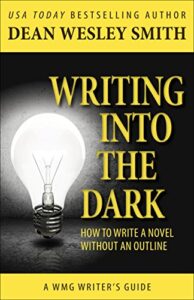 Two things aligned at the same time to get me going on “writing into the dark”. One was from Harvey Stanbrough who’s a regular commenter here at the Kill Zone. Harvey is a prolific writer, to say the least, and he PM’d me to say, “Check out Writing Into The Dark.” Harvey also told me to check out Heinlein’s Rules for Writing, which I did, and that’s material enough for a whole other post. At the same time, I was video chatting with my good friend and UK indie writer, Rachel Amphlett. Rachel also recommended I read Writing Into The Dark as it’s become her novel-writing method.
Two things aligned at the same time to get me going on “writing into the dark”. One was from Harvey Stanbrough who’s a regular commenter here at the Kill Zone. Harvey is a prolific writer, to say the least, and he PM’d me to say, “Check out Writing Into The Dark.” Harvey also told me to check out Heinlein’s Rules for Writing, which I did, and that’s material enough for a whole other post. At the same time, I was video chatting with my good friend and UK indie writer, Rachel Amphlett. Rachel also recommended I read Writing Into The Dark as it’s become her novel-writing method.
Writing Into The Dark opens with Dean Wesley Smith saying this:

He spoke to me, and Dean kept me hooked in the book until the end. What I got out of Writing Into The Dark is realizing I’ve evolved or morphed over time from a plotter to a pantster to a page-by-page drafter who’s learned to speed things up through a process Dean Smith calls “cycling”. I have to say I’ve found my stride, and I’m very comfortable drafting an entire book by outlining as I go.
Before drilling into what page-by-page, cycling, and outlining-as-you-go entails, I want to deal with a very important part of the dark writing method. Dean goes into a bit of brain science and how it applies to plotters and pansters. Plotters generally apply the critical part of their thinking process. They want to know exactly what route they’re taking in driving through the story. Pansters apply creative brain function. They thrive on allowing creativity to flow by putting the creative side first but still allow the critical brain to keep watch. Critical brains stifle creative brains every time.
Dark writers say “Fu*k it. Critical brain stay home. Me ’n ole creativity here are goin’ for a ride and hang on to yer hat maggot, ’cause this is gonna take yer breath away!”
In Dean Smith’s writing method, he goes hard and fast with only short glimpses in the work mirror. He writes a page or two at a time (page-by-page), then quickly looks back, fixes whatever, and moves on. This he calls cycling through the manuscript. Write a page or two, cycle back, fix or edit, and do it again. Throughout his page-cycle rhythm, Dean keeps a notepad at his side where he jots down ideas and story points. This is his idea of an outline.
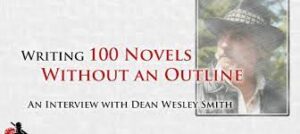 Besides reading Writing Into The Dark, I watched a video presentation Dean gave to a writers conference about his process. I also read an insightful interview with him, and I’ll snip some conversation from them. I feel Dean Wesley Smith is a master of dark writing technique (He’s written hundreds upon hundreds of books and pieces) so I’ll let him have a few words right here on the Kill Zone stage.
Besides reading Writing Into The Dark, I watched a video presentation Dean gave to a writers conference about his process. I also read an insightful interview with him, and I’ll snip some conversation from them. I feel Dean Wesley Smith is a master of dark writing technique (He’s written hundreds upon hundreds of books and pieces) so I’ll let him have a few words right here on the Kill Zone stage.
“Writing fast, writing a lot, and keeping on submitting changed the way I look at writing,” Dean says. “It changed my mindset. It taught me to trust my instincts and trust my voice. I left my voice in my stories because I didn’t rewrite everything into dullness. Rewriting kills your voice and your natural ability to tell a story.”
Dean goes on to say, “I hated the idea of writing sloppy, so when I realized something needed to be fixed, I went right back and fixed it. I developed the habit of cycling back every few hundred words and doing minor revisions, all the while keeping a handwritten outline of points beside me. But when I get to the end of the story, I leave it alone.”
Here is some advice from Dean Smith for emerging writers. “Focus on the story and moving ahead. Write more. Learn. Have fun. Keep learning and experimenting. Stop making it so serious. This is entertainment, so entertain yourself and have fun.”
 I know there’s a lot of truth in Dean’s words because dark writing is working for me. I outlined the ever-living sh*t out of my first novel. It was planned like the D-Day Invasion of Normandy. Slowly—over time—I loosened up a bit. But things changed, big time, when I spent two years writing cranking commercial web content for my slave-driving daughter’s online writing business.
I know there’s a lot of truth in Dean’s words because dark writing is working for me. I outlined the ever-living sh*t out of my first novel. It was planned like the D-Day Invasion of Normandy. Slowly—over time—I loosened up a bit. But things changed, big time, when I spent two years writing cranking commercial web content for my slave-driving daughter’s online writing business.
That meat grinder doesn’t allow for much outlining. Not if you’re going to make money, that is. It’s research, write, proof, ship, and do it all over with a new topic that you’re really not all that hyped-up on. I wrote about everything from gastroenterology to bruxism to naturopathy treatments for foul-smelling vaginal secretions on a health & wellness site — to stainless steel vat technology in the hipster cottage brew industry.
Trust me. You want to get through this stuff as fast and with as little or no pain as possible. To survive and pay the bills, I got wired on dark writing. And I brought it with me when I went back to novels. Because you’re my friends, I’m going to show you my current writing method which is almost as dark as my subject matter and soul.
I’m working through a based-on-true crime series and releasing a new product every two months. Average lengths are about 52K words, and when I’m on a roll I write 900 to 1,000 words per hour. On a good day, when I’m not sidetracked by squirrels or severely hung over, I get-in about 3,500 words. So the calculator computes I draft a new book in about 15 writing days or 55 writing hours.
I don’t pre-outline anymore. I do exactly as Dean Wesley Smith does, and I didn’t know was it was called until Rachel and Harvey told me to read his book. Whadda ya know? Dean and I have something in common.
My outline emerges as I write chapter by chapter. I know where the story goes and how it ends because I lived in or around these crimes that I’m currently writing on. You gotta cut me some slack on internally knowing this series, but I’ll do the same on the next, which I plan to do in upcoming City Of Danger. What I do is keep a running log, or flow chart, on 11×17 paper. I’ll post the images so I don’t have to do any more describing than necessary. It’s the old picture being worth a thousand words thing.
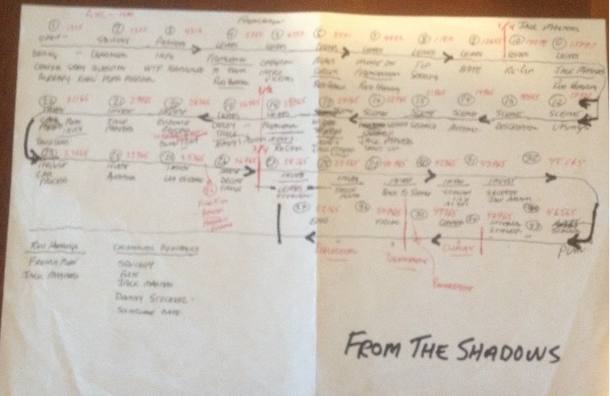
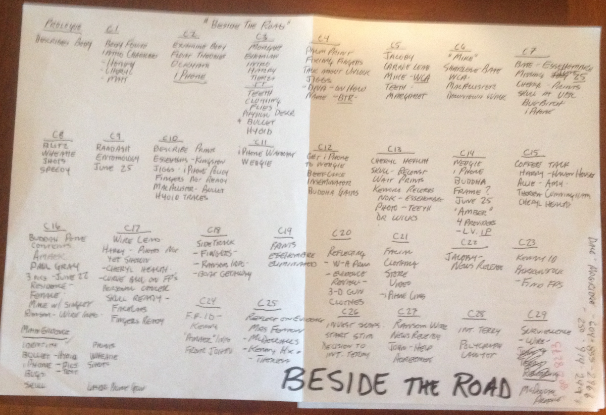
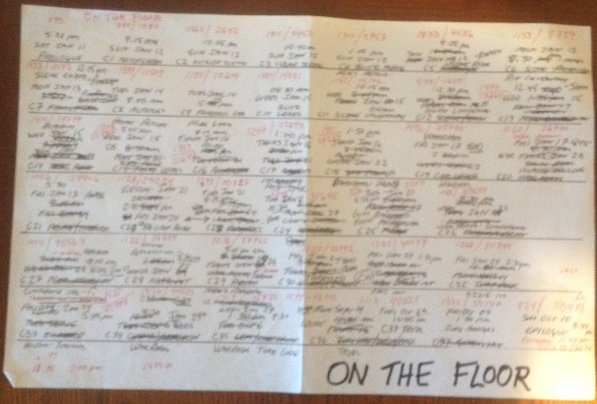
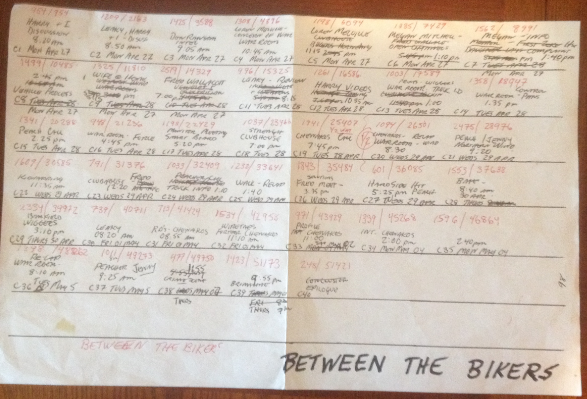
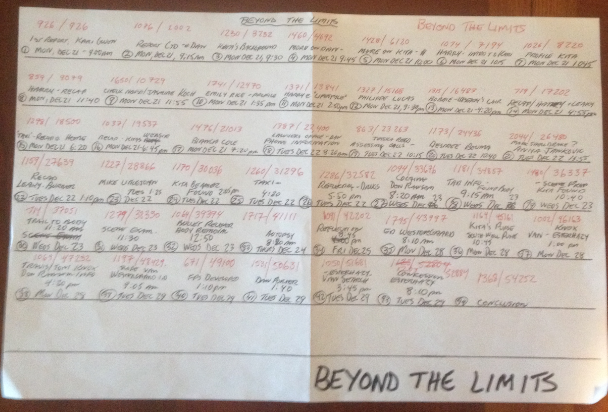

See how my outline-as-I-go has evolved? I didn’t post pics of my first two in the series, In The Attic and Under The Ground. I didn’t use one for Attic, and I’ve lost the one for Ground. When I look at the progression through From The Shadows, Beside The Road, On The Floor, Between The Bikers, Beyond The Limits, and to my nearly-finished WIP At The Cabin, I see my method slightly changing. Hopefully, improving. I’ll let you know if it ever gets perfected, but don’t hold your breath.
You’re probably wondering what all those blurry swiggles and stimbols are. I outline-as-I-go from left to right and enter the chapter (scene) number, the date and time locaters, main plot points, the chapter word count (in red), and the overall story word count (in red) as it progresses scene by scene. That’s it. That’s how I keep track of a book’s gestation. The rest is mostly in my creative side except for research downloads and general hand-noted points similar to an editor’s style sheet.
I used to do second-day editing where I’d go back over the previous day’s works, but I gave that up for what I figured out is cycling, as Dean Smith calls it. Once I get to the end, I run it through Grammarly and clean it up. Then it’s off to my proofreader who does a remarkable job of finding issues, even teeny-tiny mistakes. Oh, BTW, I write each chapter/scene on a separate Word.doc and assemble them into one full manuscript as I do the Grammarly edit.
That’s it. I’m not saying my way of writing into the dark is right or wrong. It’s just an option I thought I should share. You do what works for you, but make sure you do one thing right. That’s to keep on writing and putting it out there, just as Heinlein’s rules prescribe.
It’s your turn, Kill Zoners. Am I out to lunch with this reckless behavior? Have you tried dark writing? Tell us in the comments what your style is, and your outlining experiences are.
——
 Garry Rodgers is a retired homicide detective—an old murder cop—who went on to another career as a coroner handling forensic death investigations. Now, Garry’s returned from the bowels of the morgue and arose as an internationally bestselling crime writer. True story & he’s sticking to it.
Garry Rodgers is a retired homicide detective—an old murder cop—who went on to another career as a coroner handling forensic death investigations. Now, Garry’s returned from the bowels of the morgue and arose as an internationally bestselling crime writer. True story & he’s sticking to it.
Garry is also an indie publisher currently finishing a 12-part, based-on-true-crime series detailing investigations he was involved in. Garry Rodgers runs a popular blog site at DyingWords.net and messes around on Twitter. When not writing into the dark, Garry spends time putting around the saltwater near his home on Vancouver Island in British Columbia on Canada’s Covid free infested southwest coast.

Thanks for the nod, Garry. Yesterday I finished my 6th novel of the year (quarter) and will start something new today.
I cycle as I go (every 1000 words or so) but the secret to cycling is to read for fun (remaining in creative mind) and let the characters fill in what you might have omitted. I’m what Stephen King calls a putter-inner, and I often deepen descriptions a bit as I go. (I use all five of the POV character’s physical senses at least once in every major scene, plus what I call his “emotional sense”: dread, joy, sadness, whatever.)
And yes, I also keep a reverse outline as I go, mostly to help me remember physical characteristics of characters, etc. Helps keep a character from putting on a brown jacket that miraculously changes to blue as he sits down at the dinner table.
I used to tell my students they had a choice: they can control the characters from an ivory tower, or they can take off the robes, slip into some jeans and a t-shirt, roll off the parapet into the trenches and race through the story with the characters. I chose the latter. To me, it’s more fun that way. 🙂
Good on you for trying WITD. I never would have suspected it would work well for a true-crime novel, but I see how it would after you’ve done adequate research. And as always, whatever works for the writer is right.
And thanks to you, Harvey, for giving me the nod to Dean Smith’s book. Writing Into The Dark isn’t for everyone, that you can take to the bank. It works for me in the based-on-true-crime-series because I lived this stuff and know the characters. I just let them tell the story, and I write it down for them. The next series I’m starting is pure fiction – let’s see how it goes over there. Thanks for your comment and continual support on TKZ!
Garry, it should work even better over in straight fiction. The characters will still tell you the story, and often they’ll tell you things that your conscious, critical mind will say “that can’t be right.” But if you trust it and just write the next sentence and the next etc., almost always the characters will deliver on what they handed you way back when it didn’t make sense. That might well be the thrill of the whole thing.
The process is similar to mine, although I think it needs to be made clear to beginning writers (of fiction) that there has to be a story. Following characters is fun, but unless there’s a story, it’s not going to resonate with readers.
When I started writing, everyone was touting storyboards for plotting. I bought one. Tried it. 3 chapters ahead was the best I could do. I turned that board into my ‘tracking board’ where I summarized scenes, characters, setting, etc., after I wrote each chapter. I had another board (they came in sets of 3) so I used that one for ideas or things to fix. All done with sticky notes so I can get rid of them when I’ve resolved whatever I’ve noted. I read every chapter (from a hard copy) at night, in bed, in a non-writing environment, jot notes and then start with those the next day. My critique partners see each chapter and catch things or make suggestions (which I accept, modify, or ignore), so when I get to ‘the end’, it’s usually one more full read-through for continuity, a pass through SmartEdit for the things I can’t see, and it’s off to my editor. I outlined my process on my own blog last year.
I just hopped over to your site, Terry. *Writing Into The Shadows* – love it. I’d say you isolated the number one thing about storytelling, no matter how you tell it. It’s all about story and story comes first. The characters are just there to support it, and it’s your job, as a writer, to herd these cats along the way.
Kill Zoners – Here’s how Terry wrapped up her post titled *Writing Into The Shadows*: “Do what works for you, and don’t let anyone tell you your system will never work. Plot, outline, write into the shadows, write into the dark. It’s about writing.”
“I think it needs to be made clear to beginning writers (of fiction) that there has to be a story.”
I say it needs to be made clear to beginning writers (of fiction) that there has to be a structure. This is what connects readers to your story, pulls them in, keeps them there, and knocks them out at the end.
I’ve heard some “gurus” say structure is bunk. I’m always looking for the bestselling novels that ignore structure. It’s like looking for the blue-footed boobie. In point of fact, story and structure love each other passionately. Story can’t live (for the reader) without structure. Ignore that at your peril.
The method I’ve used over the years is based on Dwight Swain’s as described in Techniques of the Selling Writer. The idea of a “white hot” document that you add to over several days is the “dark” stuff, and from that you cull the nuggets that work for the readers and toss the rest. From there it’s a matter of planning and writing to signposts. And, of course, writing your novel from the middle!
I browsed through your post on story & structure loving each other, Jim. I grabbed this quote which I think says so, so much: “If you’re good enough, like Picasso, you can put noses and breasts wherever you like. But first you have to know where they belong.”
From my growing experience, proper structure is vital – absolutely crucial to supporting a story. Like you can’t hang a Picasso on a finished wall if your house’s foundation and frame won’t support it. Thanks for your comment, links, and always words of storytelling wisdom!
Thanks for the intro to Dean Wesley Smith’s book. I work in a similar way by outlining in reverse, discussed in this post: http://killzoneblog.com/2020/03/outlining-in-reverse.html
Ten thousand hours or a million words are often touted as requirements to achieve proficiency. Cranking out lots of words on deadline, as you did for your daughter’s website, hones craft. Pretty soon, one develops an innate sense of how a story/article/post needs to go to achieve its goal.
Garry, I remain in awe of your production, as well as Harvey’s. Maybe someday you’ll share the secret vitamin you take with us mere mortals.
I’m not so sure about Malcolm Gladwell’s 10,000 hours to perfection, Debbie. I got a lot more time in the writing chair than that, and I can’t even see the perfection horizon yet. I’m starting to believe the earth is flat and there’s no end out there.
The secret vitamin is this, and it’s supplied to me by my mentor, Adam Croft: “Arse in chair. Fingers on keys.”
I already take that vitamin, Garry. I’m talking about the secret one that makes the brain work better and the fingers type faster 😉
Oh, that one. Sorry. I don’t think it exists 🙂
Debbie, I type about 1000 words per hour on average, or a “blazing fast” 17 words per minute. Over the first 90 days of this year, I wrote an average of 3 hours per day. Not a bad gig. 🙂
What makes my production unusual is not that I show up and put time in the chair, but that so many others do not.
I agree with Terry and Jim that story and structure are important. But the characters are actually living the story. We only have to trust them. I would personally no more tell my characters how to live their lives than I would tell my neighbors how to live theirs.
And our creative subconscious has been absorbing story structure all our lives from film, books, and television, since before we even knew there was an alphabet. Again, we only have to trust the subconscious to know what it knows. Study, yes. Learn more, absorb it, yes. But then trust it. That’s the secret.
Of course, this incredibly freeing process is what works for me. I never have and never will say it’s the “only way” to write, only that if you’re able to pull the trigger on it, it’s incredibly freeing.
And the thing is, we always have a safety net. If we try it and don’t like it, we can always go back to the way we were doing things before.
Interesting post, Garry. Thanks for telling us about DSW’s book and ideas on story writing. I plan to check out his book. I currently use a hybrid technique of having an overall idea of the story, the sign posts along the way, the key scenes, and then chapter by chapter turn over the assignment to my creative brain and let go. I like the idea about “cycling” or fixing things as you go. Easier to find issues that way than waiting until a rough draft is done. My current goal is to find better ways to tap into my characters’ inner journey and conflict, adapting the plot to better show that journey, and hopefully hooking the reader more tightly.
Thanks for a great post.
Merci, Steve. That’s the French Canadian part of me coming out, and it’s about all the French I know. I like this sign post stuff that JSB was talking about. I’m going to have a better look at the links he provided in his comment this morning. Journey – isn’t that what all of us characters are on in this writing gig?
I use what I call a disappearing outline. Basically, when I get an idea, my creative brain goes 24-7, and obviously I can’t write 24-7, so I come up with ideas, organize them, and refine them way before I can start writing (especially if I’m already working on another manuscript). So I make an outline. Then, as I complete a chapter, I erase that section of the outline. Hitting that delete button is always so satisfying. Then, when I’m revising, I’ll make a new one of all the changes I want to make. Then erase that as I go. It keeps me from getting stuck with a certain framework, because it’s always changing, and even if the story content remains the same, I’ll word it differently each time I create the outline, so it gets into my brain differently.
I like to say that I daydream as a pantser, but then write as a plotter. Honestly, daydreaming is way more important, because without that, I have nothing to write. We all pants, write into the dark, and plot. It just depends on which draft we do it on (or in some cases, where in the first draft we do it.)
Great comment, AZAli. Daydreaming – the mechanism of imagination. The Australian indigenous people have a concept called dreamtime where they gently put themselves in an altered state of consciousness to get all sorts of information. Some other indigenous cultures go to enormous discomfort to achieve the same thing – sweat lodges, sun dances, vision quests. I do my best daydreaming while out on a walk along the waterfront. Whatever works, as they say, and I like your disappearing outline approach. Thanks for sharing this!
Good morning, Garry. I’m a serious story and structure nut(case) as a writer. I used to be a pure-pantser, and in fact wrote my first three novels with only an idea of the situation and premise. I tried some very light outlining with my fourth. It was my fifth where I moved to the outlining side of the writing force.
I took the outline and first 3 chapters of that novel to a two-week novel outlining workshop taught by author Kij Johnson at the University of Kansas. We workshopped our outlines (the 3 chapters were to give everyone an idea of what we were aiming for), each author getting session where the other participants provided feedback, asked questions, then helped brainstorm possibilities. In the evenings, after class, we’d assemble in the dorm common room and “fishbowl” our revised outlines, using colored post-it notes, say green for plot points, blue for character etc, on big sheets of butcher paper.
It was a terrific learning opportunity. I spent some time writing the novel out of that workshop. It didn’t work, but I learned a lot, which lead to my first fantasy series and other novels. I’m now up to seven published, but I’ve slowed down. I find myself spending more and more time in outline mode, writing an extensive journal for each novel, which is helpful, but can take the place of drafting words. I do a beat outline, with signpost structure points (hook, doorway to Act 2, mirror moment etc. pace JSB).
I’ve been working on my library mystery since fall. I’ve given myself time, because it’s a new-to-me as a writer (not a reader) and there’s a learning curve. There’s the murderer’s plot line, and the sleuth’s “arc of suspicion” as she considers various suspects, red herrings etc, as well as the B relationship story. I’m now rewriting the novel, working on sorting out problems with suspects’ motives and secrets, for instance.
Yeah, I overcomplicate things 🙂
Your post is timely, because I’d really like to become more productive, and thought about becoming at the very least, more of “plantser,” which I see as a very high-level outliner who then discovery writes the scenes. Seven published novels since 2017 isn’t bad, but I’m at a novel a year pace the last three years, and that’s not fast enough for indie publishing, nor for what I’d like to accomplish. I’ve known about Dean’s method for some time, but haven’t taken the plunge. I like Terry’s “Writing Into the Shadows” version, and Debbie’s reverse outlining approach.
Thanks for all the fuel for thought in this post.
I always read your KZ comments with interest, Dale. Your dedication to life-long learning is outstanding. I wouldn’t say you over complicate things – government bureaucracy over complicates things. Trust me – I worked in “the system” for a long time which makes me so appreciate the freedom of the indie writing world.
I wonder if we go full circle in this writing journey. I published my first novel nine years ago and it took me a year and a half to plan and outline it. IMO, that was over complicated. Now, I’m mass-producing them and shoot for 6 a year. Writing into the dark is my schtick for now and I wouldn’t be surprised at all if I go back to a structured outline in the next life. Thanks again for your comments, Dale. Always appreciated!
Loved this post, Garry! Copied and pasted into my file.
I’m a pantser. Always hated outlines in school, never learned how to do it properly. Structure is backstage waiting for me, the director, to wave it out front and center to say its lines to me. And I always listen. *Ahem* Still learning, though.
An idea floats to me on the air, and the only thing I do before putting my fingers to the keyboard is find where it should begin, and then decide how it’s going to end.
Getting there, the end, reminds me of the first time I let my son, with his newly-minted driver’s license, drive me to the store. Scary, but worth it to see the glow on his face when we arrived unscathed.
(However, I drove home. I’m not that brave…) 🙂
Great analogy, Deb.
I’m a nervous passenger, too, Deb. A bit on guard as the driver, as well. It’s not me I’m worried about. It’s all the crazies out there coming at me. To quote Richard Petty, “I’m most comfortable on the racetrack going into a curve at 200. I’m with professional drivers and we’re all going in the same direction.”
Where were we on writing before I saw that squirrel? Structure, right. Sue Coletta and I were yapping one day about pantsing & plotting and some writing guy by the name of King came up. Now Sue’s a plotter, and I won’t hold it against her, and she said she feels SK can get away with pantsing because he inherently knows story structure – it’s in his DNA. The rest of us mortals, Sue said, should stick to an outline. BTW, did anyone see Sue’s new trailer for *I Am Mayhem*? Now that’s storytelling that Sue should record in an audiobook.
Awww… *blush* Thank you, Garry!
Yer welcome 😉
I read this book a few years ago and it helped me a lot for longish short stories and even novellas, but I’ve yet to complete a full novel (but that’s on me and not the method). I will say this, it’s certainly the most fun method of writing for me. Not to sound like some sort of zen hippie, but it allows the characters to “speak to me” and guide the story. I think this method is basically how every literary author works. For genre, as JSB says, I think you need to then analyze the structure of your dark manuscript and touch it up for a polished draft that hits all the beats and tropes.
What really appealed to me in Dean’s method is the cycling part to write clean drafts. I’d already naturally been doing that in all my writing — it was something I picked up in college writing papers the night before they were due.
Hi Philip! Yeah, cycling really makes life easier – for me, anyway. Here’s a little story about my zen hippie experience the other day. I was darking away when this woman showed up outa nowhere and demanded to be in the story. I said, “No, you can’t be in the story because you’re not real and I’m basing this story on real people and basically what really happened.” She got down right insistent and I gave in and wrote her in as an eye witness – an unreliable eyewitness – and now Joyce Platt is in the book titled *At The Cabin*. Thanks for sharing your thoughts!
Garry, thanks for another very informative post. I’d never heard of “Writing into the Dark” before, but it sounds like something worth checking out.
I do wonder if different methods work for different genres. Has anybody studied that? For example, I write mystery, so I have to have at least a general idea of the puzzle before I begin. Other authors might be able to start with an idea and follow wherever it takes them. That might be a good topic for another blog post!
I am so in awe of you and Harvey. 3500 words a day? Six novels in three months? For me, I write like I run: slow, but determined. If I can turn out one good novel a year, I’ll be happy. And if each one is better than the last — well, that’s my goal.
Nice to hear you and others got some value from this, Kay. Last year, I wrote two non-fiction books on what you might call spiritual topics. I used point form outlines for both in defining the structure and then let it flow while fleshing out the subject matter. I’ve never gone outside crime and metaphysical so I have no idea of how to write something like romance. BTW, I understand Harlequin Romances have an extremely rigid structure – something like a Hallmark Christmas movie.
As for productivity, I thoroughly love getting in the zone and pecking away. 3500 words is a good average day. My best was over 6,000 and I was mentally done. Now my friend Adam Croft had a 12,000 word count one day and I guess that’s partly why he’s an uber prolific and successful indie.
Kay, to date (since October 19, 2014) I’ve written historical westerns, SF, PI/detective, magic realism, action-adventure, thriller and war novels, all with heavy romantic and psychological suspense elements and all white WITD. So I can say with certainty it does work across at least those genres.
This is essentially automatic writing so you may also channel a spirit. The good news is it may be Shakespeare or Twain although dead Twain preferred the Ouija board. (Look up Emily Grant Hutchings. It’s interesting reading.) Arthur Conan Doyle in his Spiritualism phase wrote his fiction using automatic writing.
All of this is way outside my own comfort zone as a writer, but we all have our own creative journey.
Automatic writing. Right, Marilynn. I forgot about that term. That’s exactly what dark writing is. Thanks for mentioning this, and you’re right again that we all have our own creative journey. And Happy Easter Weekend!
This is a keeper, Gary. Thank you. It certainly goes against the conventional wisdom (which, I have found at this late stage, is usually neither) but it is absolutely a legitimate method for telling a story. James Lee Burke, to name but one, has repeatedly said that he has absolutely no idea what he is going to write about when he sits down to start a novel. It seems to have worked for him from the very beginning. One has to go back and tidy things up at some point but that is true of virtually any action, whether one is planning it or winging it.
Your flow chart idea is interesting. I don’t think that I have ever seen that done before in that context. Thanks for sharing.
I mean, Garry. Sorry. I keep doing that.
I’ve been long-tempted to legally change my name to Gary Rogers 🙂
Great feedback, Joe. Thank you! The way I look at it is if this method works for James Lee Burke and Stephen King, then that’s good endorsement for me. I took James Patterson’s Masterclass on writing and the guy’s an outline Nazi. I couldn’t go to that much pre-work – he writes like half the book in his outline. But… ya can’t argue with Patterson’s success.
Regarding the flowchart, this is a leftover from my criminal investigation days where we always made a timeline for the crime. It really helps to put the case in perspective. There’s another case outlining technique called link analysis – I might just write a piece on how this “circles & squares” process can help writers frame a story.
I’ve tried it, Garry. I started out being a strict plotter, every chapter outlined. But now I’m evolving into a pantser with an occasional burst of dark writing. I find dark writing very freeing.
I think this writing path is one of continual evolution. Like you, I started as a strict outliner and slowly veered off into the dark and menacing alley. Not sure what’s at the end… Thanks for commenting, Elaine!
“Rewriting kills your voice”? Sorry, Garry, but I don’t agree with his statement at all. I also don’t agree that plotters can’t veer away from the outline. I’m constantly revising my outline when my characters zig instead of zag. As Jim stated above, stories need structure. Without some sort of framework, the story falls flat. That said, if writing into the dark works for you, then I’m happy you found a system that works for you. No two writers work in the same way. That’s what’s so awesome about writers. We’re as unique as snowflakes. 🙂
…and we melt easily at criticism. Oy!
Well said, Sister.
Hey – there you are. I knew this comment would get you riled. And I have to disagree with Dean, too, about losing the voice with rewriting. If the voice is there from the start, and the writer sticks to their guns and doesn’t allow it edited out, then it’s going to come through regardless of tweaks and twirks.
And thank God that writers are unique like snowflakes. It’d be a boring storm if we were all the same. Speaking of snowflakes, Sue, what do you think of Randy Ingermanson’s snowflake method? BTW, good voice you got there in your trailer for *I Am Mayhem* — https://www.suecoletta.com/i-am-mayhem-excerpt-video/
Thanks!
Haha. You know me so well, Garry. I think Randy’s snowflake method rocks. It’s a unique way to look at story structure, and he’s an amazing coach.
Of course I know you well. You’re my other wife, and I was totally thinking of you when I slipped in DWS’s quote about losing voice from rewriting. I went, “Wonder what I can do to get a rise outa Sue?”
Randy Ingermanson also co-wrote Writing Fiction for Dummies with Peter Economy. Luv that last name, Economy. Might just plug that in a story sometime along with Bob Canada.
I’ve been doing this forever. Now I’m mad that I could’ve written a book about it instead of keeping my mouth shut because plotters kept telling me I was wrong.
Dang.
Good to hear, Cynthia. It’s comforting to read the comments and see that I’m not getting my butt chewed off by the plotters for suggesting that dark writing works. I really was expecting to take some heat over this, but I thought I had something to say, so I said it. Plotters gonna hate…
I’m a pantser and a daily dark writer. I’ve read at least three books on outlining, but the problem for me is the voices are silent in my head. When I’m pantsing, the characters are acting out the story in real-time in front of me and it’s a matter of capturing their words on paper. I sound like a nut case and outlining looks easier, but I can’t seem to hear my characters talking to know where the story is going.
Exactly what happens to me in dark writing, Alec. In my based-on-true-crime series (doing book 8 right now) I have a one-up on outlining as I’ve lived these stories and know the characters so I let them go and just do the court stenographer thing. The more I do of this, the more I believe the best stories have plot driven by characters. Thanks for reading and commenting!
Well put, Garry. Turns out I write in the dark.
Thanks, Bill. I didn’t know I did either, until I was told what it was called.